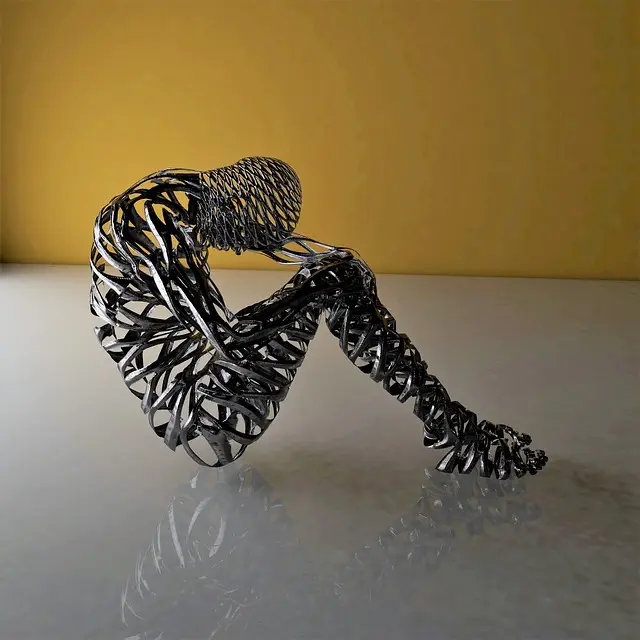Anxiety disorders, including generalized anxiety disorder (GAD), panic disorder, and social anxiety disorder, can significantly impact daily life. Kratom, a natural supplement derived from the Mitragyna speciosa plant, has gained attention for its potential anxiolytic effects and muscle relaxation properties, particularly through its interaction with opioid receptors in the brain. Its primary alkaloid, 7-hydroxymitragynine, is known to ease muscle stiffness and discomfort. However, it's important to consult healthcare professionals before using Kratom due to potential side effects and drug interactions. A holistic approach to managing anxiety disorders should include a combination of cognitive-behavioral therapy (CBT), exposure therapy, mindfulness practices, yoga, meditation, and where appropriate, Kratom, to address both mental health and physical symptoms like muscle tension. This integrative therapy strategy aims to enhance treatment outcomes and improve overall quality of life. Healthcare providers are advised to consider this dual-approach in their practice, with further scientific research needed to fully understand Kratom's therapeutic potential in managing anxiety disorders.
Exploring the complexities of anxiety disorders reveals a pressing need for comprehensive support. This article delves into the multifaceted approach of utilizing Kratom as a supplementary aid in managing symptoms, promoting muscle relaxation, and enhancing overall well-being. We will examine the scientifically supported roles Kratom plays in therapeutic regimens, navigate available support systems, and integrate psychological interventions for effective anxiety management. Join us as we unravel the potential of Kratom within the realm of anxiety support.
- Understanding Anxiety Disorders: The Role of Kratom in Managing Symptoms and Promoting Muscle Relaxation
- Navigating Support Systems for Anxiety Disorders: Therapeutic Approaches and the Impact of Kratom on Physical Well-being
- Integrative Therapies: Combining Psychological Interventions with Kratom for Effective Anxiety Management and Muscle Tension Alleviation
Understanding Anxiety Disorders: The Role of Kratom in Managing Symptoms and Promoting Muscle Relaxation

Anxiety disorders are complex conditions that can significantly impact an individual’s daily functioning and overall well-being. These disorders, which include generalized anxiety disorder (GAD), panic disorder, social anxiety disorder, and others, are characterized by persistent and excessive worries or fears. Understanding the intricacies of these mental health issues is crucial for effective treatment and management. In this context, Kratom has gained attention as a potential natural supplement that may aid in managing symptoms associated with anxiety disorders. Derived from the leaves of Mitragyna speciosa, Kratom interacts with the brain’s opioid receptors, which can lead to anxiolytic effects and promote muscle relaxation. This action is particularly beneficial for individuals experiencing tension-related symptoms that often accompany anxiety disorders. The muscle relaxant properties of Kratom are thought to be due to its alkaloid content, particularly 7-hydroxymitragynine, which can alleviate muscle stiffness and discomfort, contributing to a state of calmness. It’s important for those considering Kratom as part of their anxiety management strategy to approach it with caution and under professional guidance due to its potential for side effects and interactions with other medications. Additionally, while Kratom may offer relief from physical symptoms, it should be complemented with comprehensive mental health support and treatment tailored to the individual’s specific needs.
Navigating Support Systems for Anxiety Disorders: Therapeutic Approaches and the Impact of Kratom on Physical Well-being

Navigating support systems for anxiety disorders involves a multifaceted approach that includes both therapeutic interventions and consideration of one’s overall well-being, including physical health. Therapeutic approaches such as cognitive-behavioral therapy (CBT), exposure therapy, and mindfulness-based therapies have been effectively utilized to help individuals manage the symptoms of anxiety disorders. These treatments aim to modify dysfunctional patterns of behavior and thought associated with an individual’s perception of the cause of their anxiety. Additionally, the integration of complementary practices like yoga and meditation can further enhance coping mechanisms.
In parallel with these therapeutic methods, the role of natural supplements, such as Kratom, in promoting muscle relaxation is gaining attention among those seeking holistic relief from the physical manifestations of anxiety. Kratom, derived from the leaves of the Mitragyna speciosa tree, interacts with the body’s opioid receptors, which can lead to pain alleviation and a state of calmness. For individuals experiencing muscle tension or discomfort due to heightened stress levels, Kratom may offer a natural alternative to pharmaceutical muscle relaxants. It is crucial for anyone considering Kratom as part of their anxiety management plan to consult with a healthcare provider to ensure safe and appropriate use, especially given the nuanced legal status of Kratom across different regions. This collaboration between therapeutic approaches and natural supplements can provide a comprehensive support system tailored to the unique needs of each individual battling anxiety disorders.
Integrative Therapies: Combining Psychological Interventions with Kratom for Effective Anxiety Management and Muscle Tension Alleviation

Managing anxiety disorders often requires a multifaceted approach that addresses both the psychological aspects and the physical symptoms, such as muscle tension. Integrative therapies that combine traditional psychological interventions with alternative treatments like Kratom have shown promise in effectively managing anxiety and alleviating muscle relaxation. Kratom, derived from the leaves of the Mitragyna speciosa tree, has been used for its therapeutic properties, particularly in relieving chronic pain and muscle tension, which are common symptoms associated with anxiety disorders. Psychological interventions such as cognitive-behavioral therapy (CBT) provide individuals with coping strategies to manage anxiety, while Kratom’s analgesic effects can complement this by physically easing the tension often felt by those with anxiety. It is crucial for patients and healthcare providers to explore the therapeutic potential of Kratom in conjunction with psychological treatments, as it may enhance overall treatment efficacy and improve quality of life for individuals suffering from anxiety disorders. The synergy between these two modalities can lead to a more holistic approach to care, addressing both the mental and physical manifestations of anxiety. As such, Kratom’s inclusion in a comprehensive support plan merits careful consideration by medical professionals and further research to understand its full potential in the context of anxiety management and muscle relaxation.
In conclusion, anxiety disorders present complex challenges that require a multifaceted approach for effective management. This article has explored the significant role of Kratom in supporting individuals with anxiety, particularly through its beneficial effects on muscle relaxation. It is clear that integrating Kratom into support systems can complement therapeutic approaches, enhancing overall physical well-being and contributing to a more holistic form of care. Understanding the intricacies of anxiety disorders and utilizing evidence-based interventions, alongside the judicious use of Kratom, provides a pathway towards improved symptom management and quality of life for those affected by these conditions. It is imperative that ongoing research continues to elucidate the potential of Kratom in this domain, ensuring its safe and effective application within the context of comprehensive support systems for anxiety disorders.






